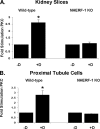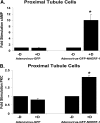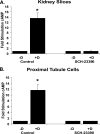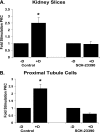Sodium-hydrogen exchanger regulatory factor 1 (NHERF-1) transduces signals that mediate dopamine inhibition of sodium-phosphate co-transport in mouse kidney
- PMID: 20200151
- PMCID: PMC2859505
- DOI: 10.1074/jbc.M109.094359
Sodium-hydrogen exchanger regulatory factor 1 (NHERF-1) transduces signals that mediate dopamine inhibition of sodium-phosphate co-transport in mouse kidney
Abstract
Dopamine inhibited phosphate transport in isolated renal brush border membrane vesicles and in cultured renal proximal tubule cells from wild-type but not from NHERF-1 null mice. Co-immunoprecipitation experiments established that NHERF-1 associated with D1-like receptors. In wild-type mice, dopamine stimulated cAMP accumulation and protein kinase C (PKC) activity in renal proximal tubule cells, an effect that was abolished by SCH-23390, a D1-like receptor antagonist. In NHERF-1 null kidney tissue; however, dopamine failed to stimulate either cAMP accumulation or PKC activity. Infection of proximal tubule cells from NHERF-1 null mice with adenovirus-green fluorescent protein-NHERF-1 restored the ability of dopamine to stimulate cAMP and PKC. Finally, in (32)P-labeled wild-type proximal tubule cells and in opossum kidney cells, dopamine increased NHERF-1 phosphorylation at serine 77 of the PDZ I domain of NHERF-1, a site previously shown to attenuate binding of cellular targets including the Npt2a (sodium-dependent phosphate transporter 2a). Together, these studies establish that NHERF-1 plays a key role in dopamine signaling and is also a downstream target of D1-like receptors in the mouse kidney. These studies suggest a novel role for the PDZ adapter protein NHERF-1 in coordinating dopamine signals that inhibit renal phosphate transport.
Figures










Similar articles
-
Cooperativity between the phosphorylation of Thr95 and Ser77 of NHERF-1 in the hormonal regulation of renal phosphate transport.J Biol Chem. 2010 Aug 13;285(33):25134-8. doi: 10.1074/jbc.M110.132423. Epub 2010 Jun 22. J Biol Chem. 2010. PMID: 20571032 Free PMC article.
-
Fibroblast growth factor-23-mediated inhibition of renal phosphate transport in mice requires sodium-hydrogen exchanger regulatory factor-1 (NHERF-1) and synergizes with parathyroid hormone.J Biol Chem. 2011 Oct 28;286(43):37216-21. doi: 10.1074/jbc.M111.288357. Epub 2011 Sep 9. J Biol Chem. 2011. PMID: 21908609 Free PMC article.
-
Parathyroid hormone inhibits renal phosphate transport by phosphorylation of serine 77 of sodium-hydrogen exchanger regulatory factor-1.J Clin Invest. 2007 Nov;117(11):3412-20. doi: 10.1172/JCI32738. J Clin Invest. 2007. Retraction in: J Clin Invest. 2013 Jun;123(6):2752. doi: 10.1172/JCI70657. PMID: 17975671 Free PMC article. Retracted.
-
The role of NHERF-1 in the regulation of renal proximal tubule sodium-hydrogen exchanger 3 and sodium-dependent phosphate cotransporter 2a.J Physiol. 2005 Aug 15;567(Pt 1):27-32. doi: 10.1113/jphysiol.2005.086777. Epub 2005 Jun 2. J Physiol. 2005. PMID: 15932893 Free PMC article. Review.
-
Role of NHERF and scaffolding proteins in proximal tubule transport.Urol Res. 2010 Aug;38(4):257-62. doi: 10.1007/s00240-010-0294-1. Epub 2010 Jul 15. Urol Res. 2010. PMID: 20632170 Review.
Cited by
-
NHERF-1 and the regulation of renal phosphate reabsoption: a tale of three hormones.Am J Physiol Renal Physiol. 2012 Aug 1;303(3):F321-7. doi: 10.1152/ajprenal.00093.2012. Epub 2012 Apr 25. Am J Physiol Renal Physiol. 2012. PMID: 22535796 Free PMC article.
-
Ezrin-anchored protein kinase A coordinates phosphorylation-dependent disassembly of a NHERF1 ternary complex to regulate hormone-sensitive phosphate transport.J Biol Chem. 2012 Jul 13;287(29):24148-63. doi: 10.1074/jbc.M112.369405. Epub 2012 May 24. J Biol Chem. 2012. PMID: 22628548 Free PMC article.
-
Dopamine regulation of Na+-K+-ATPase requires the PDZ-2 domain of sodium hydrogen regulatory factor-1 (NHERF-1) in opossum kidney cells.Am J Physiol Cell Physiol. 2011 Mar;300(3):C425-34. doi: 10.1152/ajpcell.00357.2010. Epub 2010 Dec 15. Am J Physiol Cell Physiol. 2011. PMID: 21160026 Free PMC article.
-
Renal control of calcium, phosphate, and magnesium homeostasis.Clin J Am Soc Nephrol. 2015 Jul 7;10(7):1257-72. doi: 10.2215/CJN.09750913. Epub 2014 Oct 6. Clin J Am Soc Nephrol. 2015. PMID: 25287933 Free PMC article. Review.
-
The renal dopaminergic system: novel diagnostic and therapeutic approaches in hypertension and kidney disease.Transl Res. 2015 Apr;165(4):505-11. doi: 10.1016/j.trsl.2014.07.006. Epub 2014 Jul 25. Transl Res. 2015. PMID: 25134060 Free PMC article. Review.
References
-
- Cunningham R., Steplock D., E X., Biswas R. S., Wang F., Shenolikar S., Weinman E. J. (2006) Am. J. Physiol. Renal Physiol. 291, F896–F901 - PubMed
-
- Weinman E. J., Hall R. A., Friedman P. A., Liu-Chen L. Y., Shenolikar S. (2006) Annu. Rev. Physiol. 68, 491–505 - PubMed
-
- Hall R. A., Lefkowitz R. J. (2002) Circ. Res. 91, 672–680 - PubMed
Publication types
MeSH terms
Substances
Grants and funding
LinkOut - more resources
Full Text Sources
Molecular Biology Databases
Miscellaneous

